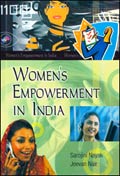Contribute
| Book Review - Women's Empowerment In India |
Reviewer - Samita Jena
09/21/2005
Woman’s Empowerment in India
Authors-Sarojini Nayak and Jeevan Nair
Published by Pointer Publishers, Jaipur, Rajasthan.
Pages 398, Price Rs 995/-
Review by Samita Jena.
The book as described in the preface “is an attempt to
trace the journey of the status of the Indian women in
society from the Vedic period to the 21st century.â€
It traces the evolution of Indian women through the
mists of history to the present efforts to empower
them and give them their rightful place in society.
Divided into five broad sections – Marriage in India,
Man-woman relationships, Egalitarianism, the New
millennium and Empowerment at work – it is the third
section that deals with the dynamic processes of
empowerment that are visible in the country today.
Issues such as sexual inequalities, women liberation,
woman’s role in the family and status of women are
reflected upon, keeping in view the changing social
norms. Besides, other vital indicators of empowerment
such as legal status, political status, woman’s
education, right to work, institutional changes and
constitutional amendments are highlighted with the
latest available statistics. Various welfare
programmes undertaken by the government for expanding
education, family planning, health services, and such
other continuous efforts by organizations for the
upliftment of women are discussed at length, with a
view to provide a total framework of the total
empowerment experiments that have strengthened the
movement.
The International Woman’s Decade is a landmark period
in the woman’s empowerment process in India. This
period witnessed unprecedented efforts from various
sectors to reassess the role of women, to enlarge the
information base, to search for alternative strategies
for women’s development and special policies were
framed to address the needs of women. The role of
institutions such as Committee on the Status of women
in India, Working group on employment of women,
National Committee on women, National Conference, and
forums such as Indian Association of women’s studies,
National Movement for Eradication of women’s
illiteracy and organizations like Self Employed
Women’s Associations, is analyzed in detail.
However, it cannot be said that the book is a complete
documentation of the empowerment saga, but it does
provide a comprehensive picture to the common reader.
One has to keep in mind that the subject is not an
easy one, taking into account the social, economic,
political, religious and cultural diversity that
prevails in the country. The authors with all humility
accept the limitations of the study, as “we have tried
to present as comprehensive an image as possible of
the position of the Indian women as the diversities
and inequalities prevailing in our society for
millennia of years render the assigning of any precise
role to the women well-nigh impossibleâ€.
END
You may also access this article through our web-site http://www.lokvani.com/
